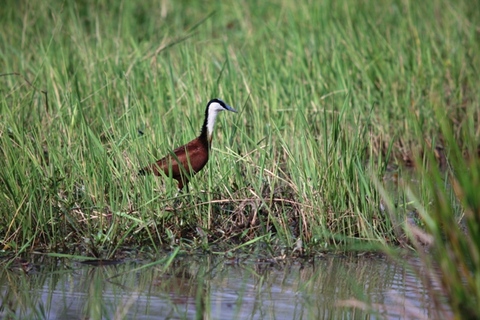 Muni-Pomadze Ramsar Site
Muni-Pomadze Ramsar Site
This Ramsar site is located in Winneba in the Central Region of Ghana. It is made up of the Muni Lagoon, the surrounding flood plains and the adjacent sandy beach on the seafront. It provides feeding or staging habitats for migrating waders that spend the non breeding season in Ghana and as roosting site for terns.
| Release date | 04/09/2010 |
|---|---|
| Contributor | Eric Okoree |
The Muni-Pomadze Ramsar Site, situated to the west of the coastal town of Winneba in the Central Region, was designated as a Ramsar site in 1992 and includes two forest reserves (i.e. Yenku Block A & B). The site comprises the Muni Lagoon, the surrounding flood plains and the adjacent sandy beach on the seafront. The Yenku Forest Reserve and the traditional hunting grounds of the Efutu people are important features within the site.
The lagoon is a shallow, saline, semi-closed coastal lagoon, with a surface area of about 300 ha and is heavily fished during the lean season. The hill slopes facing the lagoon are fairly steep. The lagoon shoreline is covered by Sesuvium portulacastrum, Paspalum virginicum and Sporolobus virginicus in successive order up the dune side. The vegetation in the northern limits of the wetland included mangroves, with Typha australis and Ludwigia erecta and other typically freshwater hydrophytes occurring further inland. The vegetation in the upland areas is dominated by grassland, thickets and pockets of Eucalyptus and Cassia plantations.
 Forty-eight (48) species of waterbirds comprising of 29 species of waders, eight species of terns, two species of gulls, seven species of herons and egrets, one species each of duck and cormorant have been recorded at the site. The most abundant waterbird species are the Calidris ferruginea, Charidrius hiaticula, Tringa nebularia, Himantopus himantopus, Chlidonias niger, Sterna hirundo, S. maxima and S. sandvicensis. In addition to supporting internationally important numbers of four species of terns, the site provides feeding/staging habitats for migrating waders that spend the non-breeding season in Ghana or pass through to winter further south, and as a roosting site for terns.
Forty-eight (48) species of waterbirds comprising of 29 species of waders, eight species of terns, two species of gulls, seven species of herons and egrets, one species each of duck and cormorant have been recorded at the site. The most abundant waterbird species are the Calidris ferruginea, Charidrius hiaticula, Tringa nebularia, Himantopus himantopus, Chlidonias niger, Sterna hirundo, S. maxima and S. sandvicensis. In addition to supporting internationally important numbers of four species of terns, the site provides feeding/staging habitats for migrating waders that spend the non-breeding season in Ghana or pass through to winter further south, and as a roosting site for terns.
The main threats to area are hunting, habitat destruction through bushfires and extraction for fuel wood and over-fishing in the lagoon.
